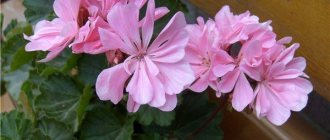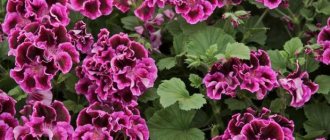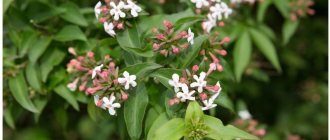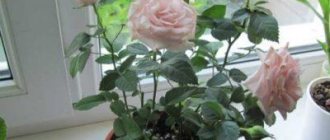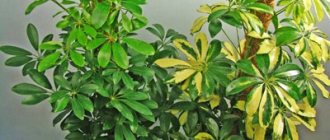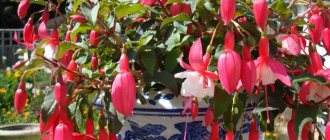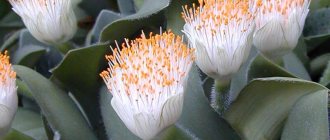Botanical description of the plant
The plant is popularly called royal geranium, although it belongs to the genus Pelargonium of the Geraniaceae family, subclass Rosidae. It has a lot of alternative names: domestic pelargonium, large-flowered, English, noble. It was bred artificially and came from closed-leaf pelargonium (cap geranium).
It is a potted plant but can grow into large bushes in mild climates. This geranium differs from other representatives in the shape and structure of the flower, as well as the splendor and arrangement of the inflorescences (not above the bush, but flush with the leaves). It blooms when it gets warm - from about April to August. The table below provides a brief description of the main morphometric parameters.
| Parameter | Description |
| Root system | fibrous |
| Stem | Erect, dense, almost completely hidden under the leaves |
| Leaf Shape | Simple, lobed, with a wavy, sometimes jagged edge |
| Leaf color | Greens |
| Flower shape | Large (usually from 4 to 7 cm), most often double, collected in umbrella-shaped inflorescences. Irregular, zygomorphic with only one plane of symmetry. The flower has a long nectar-bearing spur fused with the peduncle |
| Flower color | Varied: white, pink, red, lilac, maroon, purple. Characterized by dark veins and spots |
| Taste of Flowers | Bitterish, with a fruity minty note and rose aroma |
| Fruit shape | A long, narrow box with sepals, similar to the beak of a bird (hence “pelargos”, in Greek - “stork”) |
| Fruit color | Green, brown when ripe. |
Botanical description and history
Pelargonium Grandiflora is a small bush, which during flowering is completely covered with lush buds. Sometimes the variety is called English, although to this day it is not entirely known where it came from. In England the flower is known as the “royal” or “show” variety , and in the USA it is called “Lady Washington”.
The plant is highly valued by flower growers all over the world. Most attractive are the large, immediately noticeable flowers. The aroma does not come from the buds, and the flowering period is not very long, only about 3-4 months.
Reproduction
The easiest way to propagate domestic pelargoniums is cuttings. To do this, cuttings are cut from a well-developed mother plant from the top of the shoot, with 4 - 5 leaves, which must be placed in a bowl of water, where you can add aloe juice, honey or a little yeast. In such conditions, the cuttings will very quickly produce roots, after which the finished material can be planted in a pot with greenhouse or garden soil and kept for several days in a dark place for quick rooting.
You can propagate pelargonium by seeds, then the plant turns out to be more compact; with such propagation, abundant flowering is observed in large inflorescences, but this is a troublesome task for beginners, inexperienced gardeners.
Transfer
For several years, royal geranium can grow quietly in one pot. In addition, it is painful to transplant into open ground in the summer, unlike other varieties. The procedure is carried out only when the root system has completely filled the planting container. The new pot should be 1.5 cm larger than the previous one. A pot that is too large will slow down the growth of the flower and cause a prolonged absence of flowering.
Attention! Due to frequent transplants and changes in location, royal pelargonium may die
Royal geranium does not tolerate frequent transplants
It is better to plan geranium transplantation work for the period from February to April. Having emerged from the dormant period, the plant takes root well and enters the active growth phase. In summer and winter, unless absolutely necessary, you should not disturb the flower.
Breeding and planting
It is very easy to propagate geraniums vegetatively. In spring or summer, it is necessary to cut off the tops of stems with several nodes. Sprinkle the damaged area with activated carbon powder and place it on paper in the shade to dry for a couple of hours. During this time, prepare the substrate for planting. Mix peat and sand in a container. Plant the cuttings in moist soil. Cover with polyethylene to create a greenhouse effect. This will better regulate substrate humidity and heat.
In water, shoots very rarely take root and more often rot. Periodically, using a spray bottle, you should moisten the soil of the “babies”. After about 3-4 weeks, the cutting will take root. Then it can be planted in a permanent place, in a larger container. The soil should consist of leaf and turf soil, sand. The “babies” can bloom as early as July.
It is important to know that pelargonium does not like free space, so the pot is selected so that the roots are a little cramped. Transplantation is carried out after flowering no more than once every 2-3 years.
After the procedure, flowering may decrease. During the transplantation process, all weak and elongated shoots are removed
You need to move it very carefully so as not to injure the root system. Good drainage must be ensured
It is better to purchase ready-made fertile soil at a flower shop.
Plant propagation
There are such ways to reproduce this beauty:
- growing from seeds;
- grafting to other varieties (used by experienced gardeners).
Using cuttings
This method is considered the simplest, most convenient, and most importantly – effective. The ideal period for cuttings begins in the second half of August and ends in early September.
You need to cut off the tops. The length of the segment should be 7-10 cm. Each cutting must have 2-3 nodes. After pruning, the future sprout should dry out slightly. To do this, it is left to lie down for 2 hours.
In water, cuttings can rot and not take root, so it is better to plant them in previously prepared soil.
Preparatory activities include the following:
- The earth is mixed with coarse sand.
- The soil is roasted in the oven or treated with a solution of potassium permanganate.
- Allow the soil to settle for 48 hours.
Do not cover the cuttings with film after planting. The rooting process takes about a week. At the end of this period, the sprouts can be transplanted into a permanent pot. For more intensive growth, you can carefully cut off the leaves on the branch. This way, all the plant’s strength will be spent on developing the root system.
Sprout from a seed
The flower from royal geranium can also be obtained from a seed. Such propagation will require more effort from you, but as a result you will get a more resilient plant. The flowering period of such grandiflora is longer.
The soil should consist of peat and sand. You can add a little ash to improve the quality of the soil. Sowing is carried out in mid-February. Pelargonium seeds are small and oblong; they are planted in shallow containers. It is necessary to make a hole 0.5 cm deep.
A month after planting, the first shoots will appear. As soon as 2 leaves are formed on the sprout, it is necessary to pick it into a pot.
Diseases and pests of pelargonium
Gray rot. Symptoms: the lower leaves become covered with brown spots, which later spread throughout the plant. The leaves change color and dry out. Some areas of the flower are covered with a gray coating. Reasons: waterlogging of the soil, lack of ventilation, increase in nitrogen in the soil. Treatment: treat the flower with fungicidal agents.
Alternaria blight. Symptoms: petioles, leaf margins and leaf blades are covered with dark spots with a light center. The spots have a velvety formation. The leaves change color and dry out. There is no flowering. Causes: problem in the soil. She's infected. Treatment: proper care, treatment with fungicidal preparations.
Rhizoctonia rot. Symptoms: the appearance of dark spots on the stems, they are depressed in nature, the spots rise 25 cm along the stem. Leaves change color and wilt. The plant does not bloom. Cause: contaminated soil. Treatment: soil change, fungicide treatment.
Verticillium wilt. Symptoms: change in leaf color, blackening, wilting, no flowering. Reason: using the same primer for a long time. Treatment: get rid of remnants of vegetation in a timely manner, use clean substrates, and monitor soil moisture.
Rust. Symptoms: clearly shaped reddish spots appear on the plant. Causes: infection through water and air. Treatment: stop watering, trim leaves, treat with fungicidal agents.
Late blight of geranium. Symptoms: rapid decay, dry leaves, stops blooming, depressed spots on the roots. Causes: the infection is in the soil. Improper care, elevated temperature, excess fertilizer. Treatment: use the right soil, ventilate the soil, stop watering, treat with antibacterial drugs.
Rotting of stems and roots. Symptoms: flowering stops, fades, dies. Dark brown depressed formations appear on the neck and root. Later, suppuration of the affected areas begins. Reasons: contaminated soil, improper care, poor lighting, increased air temperature, increased nitrogen readings in the soil. Treatment: reduce watering, treat with fungicidal agents.
Leaf spotting and curling. Symptoms: does not bloom, spots on the leaf, grow over time, have a yellow color, sometimes the structure becomes oily. Causes: changes in leaf nutrition, the plant is affected, infectious insects can carry it. Treatment: treatment with fungicide. When propagating, use healthy plants.
Difficulties in growing
When growing and caring for Royal pelargonium at home, gardeners often encounter difficulties. The most common problems are:
- Yellowing of leaves. The reason for this can be determined by carefully examining the flower. If the leaf is elastic and only the tips turn yellow, then most likely the plant does not have enough moisture. If the leaves are limp and rotting, the reason may lie in the opposite - in overwatering.
- The foliage turns red. This may occur due to the room temperature being too low. The plant should be removed to another place, away from the window.
- Falling leaves. This problem usually occurs due to insufficient lighting, excess nitrogen content in the soil or excessively dry indoor air.
The plant should be replanted every 2-3 years.
The most common question among amateur gardeners is why pelargonium does not bloom. Such a nuisance can be caused by many reasons, among which the most common are:
- Fungal infections and rot. A careful inspection of the leaves, stem and root zone should be carried out. The affected areas of the plant should be removed and the flower treated with fungicides.
- An overly spacious pot: as already mentioned, Royal geranium blooms more readily in a cramped pot.
- Insufficient lighting. In this case, the stems lengthen excessively and the flower stalks do not develop.
- Low air temperature in spring and winter or excessively high in summer.
Proper care of pelargonium at home will ensure annual abundant and long-lasting flowering of the plant. The main thing is to care for it with love, then the flower will delight its owners with its beauty for a long time.
Caring for large-flowered pelargonium Grandiflora
Caring for Grandiflora pelargonium at home should be comprehensive.
Temperature
Hydrangea Grandiflora - description, planting and care in open ground
This is a very heat-loving crop that can tolerate increases in parameters up to 30 °C. During the growing season, the plant requires a temperature of at least 24 °C.
Important! In order for the plant to bloom magnificently next year, it requires a period of rest in winter. In this case, it is necessary to maintain the temperature at 12-14 °C.
Watering and spraying
It is recommended to water pelargonium with settled water. It should be at room temperature. The frequency of watering depends on temperature indicators. In hot weather, the soil needs to be moistened sufficiently. In this case, excess moisture should be removed from the pan. It is necessary to water the bushes only when the top layer of soil dries out.
When keeping a plant in a cool room in winter, it needs to be watered quite rarely, given the condition of the soil.
Loosening
After each moistening of the soil, it needs to be loosened a little. Thanks to this, it will be possible to provide the plant’s root system with a sufficient amount of oxygen. The procedure should be performed very carefully to avoid damage to the roots.
Air humidity
The plant tolerates moist and dry air normally. The culture has rough leaves, so it does not need spraying. It is best to grow zonal pelargonium in conditions of moderate humidity.
Feeding
In order for a flower to develop normally, it requires a sufficient amount of nutrients, so the plant must be systematically fed. In spring and summer, fertilizers are applied at intervals of 10 days. In autumn and winter they should be used every 3 weeks. You can feed the crop with special means.
The plant must be fertilized with minerals in a timely manner.
Trimming
To form a lush and compact plant, it needs to be pruned. This procedure is recommended to be performed in the fall. In this case, the shoots should be cut by a third. Removing dry and damaged fragments is of no small importance.
For your information! If there are a large number of shoots, pruning is performed in several stages. This helps minimize stress on the culture.
Transfer
It is recommended to replant young plants every year. From 3 years of age, transplantation is carried out only when the pot is filled with roots. It is important to use a pot 2-3 cm larger than the old one. If you take a container that is too large, flowering will not occur.
Pelargonium needs to be replanted into a ready-made substrate for flowering plants. You can also make it yourself by mixing turf soil, humus and clean river sand in a ratio of 8:2:1. It is necessary to pour drainage at the bottom, which will help avoid stagnation of moisture. If this is not done, there is a risk of root rot.
Variety of species
Due to its attractive appearance and ease of care, the flower attracts the attention of not only indoor plant lovers, but also breeders who have bred a large number of geranium varieties. Hybrid varieties differ in the size of the bush, color and shape of leaves and flowers
Particularly popular among gardeners is variegated and dwarf pelargonium, with bicolor and double flowers. Thanks to the work of breeders, about 300 species of this indoor plant have been bred. Pelargonium can have different forms: shrub, subshrub or herbaceous plant.
Depending on the variety, geranium is used to decorate rooms, garden plots, balconies and loggias. Varieties of ampelous, succulent, and fragrant pelargonium have been developed. At home, large-flowered varieties of pelargonium are usually bred.
Indoor pelargonium. The plant has dark green leaves with dark brown edges. The width of the border may vary depending on the variety of geranium. Sometimes it is called the “grandmother’s” flower. Indoor geranium flowers are varied. The plant can have simple, double and semi-double flowers, having different shapes and number of petals.
Pelargonium ivy-leaved. This is an ampelous plant with flowing long shoots, the length of which can exceed one meter. Pelargonium is often planted in hanging flowerpots. The geranium leaves of this variety are smooth, glossy, and bright green. Outwardly, they look like ivy leaves. This similarity is why the variety got its name.
Geranium Angel. This is also a hanging variety, but with shorter shoots
Particular attention is drawn to the flower, which resembles the shape of a pansy. The flowers are arranged in inflorescences, looking like bouquets.
Geranium fragrant
This type of pelargonium is loved by gardeners for its variety of scents. Fragrant varieties of pelargonium contain a large amount of phytoncides, thanks to which the leaves of the flower have a unique aroma. The aroma is especially strong when you touch the flower. Externally, the plant is not as attractive as flowering species. Fragrant pelargonium has large, slightly grooved leaves with slight pubescence on the surface of the leaf blade. The size of the leaves is quite large with uneven serrated edges. The flowers are simple white or pink. This species is characterized by strong shoot growth. Therefore, it needs the formation of a bush. To form a beautifully shaped shrub, you should periodically pinch the tops of the shoots.
Royal geranium. One of the most beautiful types of pelargonium. Particular attention is drawn to large flowers, which are collected in large inflorescences of large sizes. As a result, the inflorescence cap looks gigantic. The petals can have a variety of colors, their surface can be decorated with veins, borders, spots or specks.
Geranium Unicum. This variety of flower combines the best features of other species. Its flowers are distinguished by unusual colors with veins and patterns on the surface. The leaves of the shrub also have decorative qualities and have a light aroma.
Miniature geraniums. These species are represented by small-sized shrubs. They do not require additional pruning and crown formation. They are well suited for home keeping. Dwarf or miniature pelargoniums combine several varieties:
- Rosaceous geraniums - their flowers look like pink buds collected in inflorescences;
- cactus-shaped geraniums - flowers have an unusual shape. Their petals are cone-shaped and curled into the shape of cactus spines;
- star geraniums - flower petals are slightly pointed at the tip, quite narrow and look like stars;
- carnation pelargoniums - the flowers look like carnations because they have jagged, needle-like petals.
https://youtube.com/watch?v=p3m8V92rtNc
Pelargonium Grandiflora: main features
The main difference between large-flowered pelargonium and other varieties is the structure of the flower and the type of foliage.
The bud is formed by 5 petals - 3 large upper ones and 2 smaller lower ones, while the diameter of the flower when fully bloomed can vary from 7 to 15 cm, depending on the growing conditions and the qualities of the variety.
The leaves are characterized by jagged edges, high plate density, roughness and the absence of a “geranium” aroma.
The height of an adult bush reaches 30-60 cm, the crown is covered with bright caps of a wide variety of colors, from snow-white to burgundy and purple shades.
The flowers are most often double, but there are also varieties with simple inflorescences.
Individual specimens look very impressive - the presence of a dark spot in the center or stripes along the petals, as well as slight waviness or corrugation of the edges turn the buds into a real work of art.
The inflorescences of Grandiflora pelargonium are at the same level with the foliage, and do not rise above the crown, as in zonal and other varieties.
The formation of flower buds occurs in March, the budding period ends in the second half of summer.
Thus, you can admire the caps for 3-4 months, but even during this time, pelargonium can show a capricious disposition and drop its inflorescences.
The success of cultivation is largely determined by the stability of conditions, agricultural technology and care.
Diseases and pests
It’s a pity, but such a beautiful plant can have health problems. The most common diseases that can affect pelargonium are:
- Powdery mildew. With this disease, a powdery coating appears on the leaves and stems of the bush. Treatment is carried out using Bordeaux mixture, Topaz, and copper sulfate solution.
- Leaf rust. When a plant is infected with a fungus, small yellowish spots appear on top of its leaf blades, and rust-colored pads appear below. It will not be possible to save a diseased flower. It should be thrown out along with the soil. To prevent fungal diseases, you need to use well-drained soil, do not overwater the plant, and prevent it from overcooling.
- Root rot. The appearance of brown damage on the stems and a gray coating on the leaves indicates that the plant has rot on the roots. It should be destroyed.
- Necrotic viral spots. Purple-brown lesions appear on a flower affected by the virus. Such a plant is destroyed. Viruses are transmitted by pests, so when they appear, it is necessary to use insecticides.
- Leaf spotting. The fungal disease appears as blistering spots on the underside of the leaf blade. Infected leaves must be cut off and the bush treated with fungicidal preparations.
Pelargonium is not spared by pests either. Of these, geraniums are most often inhabited by:
- Aphids are small green or gray insects that can be found on the undersides of leaves. Their presence can also be recognized by small spots on the foliage, which fades and falls over time. To destroy aphids, it is necessary to treat the bush with an insecticidal preparation.
- Whitefly – These moth-like insects live on the underside of leaves. They feed on the sap of the plant, which is why the leaves first turn yellow and fall off, and then the entire flower dies. Whiteflies multiply very quickly, so when they appear, the entire bush must be immediately sprayed with one of the insecticidal preparations.
Diseases
Unfortunately, pelargonium grandiflora is susceptible to numerous diseases, most often due to improper maintenance. So, with excess moisture and unsterilized soil, the plant may develop blackleg or late blight. There is also gray rot of pelargonium, which is unique to these plants and is not transmitted to other types of green pets. When the first signs of diseases appear, such as spots and deformations on stems and leaves, the plant should be treated with a systemic fungicide.
Winter care
If, after the flowers fall, pelargonium is left on a warm windowsill until next spring, there may not be another flowering. With the arrival of autumn, when the temperature drops, the rules of care change. For three months the following must be provided:
- 12−15 °C;
- infrequent watering, only to maintain decreased activity;
- sufficient lighting.
No fertilizing is carried out in winter. If all conditions are met, the plant produces enough flower buds.
Transplantation and feeding
All pelargoniums have rapidly growing aerial parts. If the roots of a bush that has grown over the summer, together with the soil from the pot, have entwined an earthen ball, at the end of winter the geranium is replanted. The soil should be loose, allow enough air to pass through and retain moisture. As for selecting a soil mixture, a good option is a mixture of equal parts of sand, peat and disinfected garden soil.
Since the roots do not tolerate stagnant moisture, pelargonium needs a powerful drainage layer
When planting, no less attention is paid to the choice of pot. Geraniums do not bloom due to transplantation into too large containers
In a large pot, the plant very quickly grows green mass, but “ignores” the set of buds. A similar process is also observed with an incorrectly selected fertilizer mixture. When there is more nitrogen in fertilizers during bud formation and flowering, the stems and leaves grow, and the number of buds decreases. The best mixtures have a high content of phosphorus and potassium, which ensures long-term abundant flowering.
Plant pruning
Royal pelargonium may not bloom due to improper or insufficient pruning. Since the flower grows quickly and the buds form at the tops of the shoots, it is easy to increase the number of flower buds by pinching or trimming the tops of overgrown stems in July and August. Thanks to this it is possible to:
- Obtain cuttings for propagation.
- Achieve lush flowering next season.
- Stimulate the growth of fresh shoots.
- Make the bush compact and attractive.
It is recommended to prune gradually so as not to seriously injure the plant. After this procedure, pelargonium must be fed. Pruning is completed at the end of winter, when new bud formation begins.
Home care
Watering and loosening the soil
Pelargonium needs constant and abundant watering. But it should be remembered that waterlogging should not be allowed. Otherwise, there is a high probability of rotting of the root system. A break between procedures is necessary. Until the top layer of soil dries, you should not water. Use soft water that has stood for several days.
If the gardener notices that Grandiflora drops its flowers immediately after they appear, it means the soil is too wet. In this case, you need to wait until the next watering. But if the leaves dry out and turn yellow, this is a clear sign of a lack of fluid.
Pelargonium does not need spraying. Water that gets on the petals causes stains and stains, which only spoil the decorative effect. Loosening is an integral part of care. With this procedure, fresh air freely enters the soil.
Loosening is carried out after watering, once every 2-3 months.
Before pelargonium Grandiflora begins to bloom, nitrogen fertilizers containing calcium are needed. When the inflorescences begin to form, nitrogen fertilizing is stopped.
You should not apply fertilizer too much or too often, because having an excess of minerals in the soil, the leaves of the plant turn yellow.
To maintain the compactness of the bush, timely pinching of growing shoots is required. New inflorescences are not formed if there are dry buds on the flower, so they are removed.
The pruning procedure is done in the fall. In order not to injure the pelargonium, the shoots are removed in stages, and not all at once.
The pet has a bad attitude towards transplants. It is better not to touch an adult bush that is fully formed unless absolutely necessary.
Landing rules
Let's get acquainted with the basic rules regarding planting dwarf pelargonium.
Lighting and location selection
Important! In order for dwarf pelargonium to bloom beautifully and for a long time, it needs to grow in a well-lit place. With enough sunlight, the plant's petals are brighter and greener.
If pelargonium experiences a lack of light, its decorative effect will fade: there will be fewer inflorescences and the leaves will turn pale.
However, the plant does not tolerate direct rays: at midday, therefore, it is recommended to shade pelargonium. In winter, so that the flower does not lose its decorative effect, it needs to be provided with additional artificial lighting.
In order for the crown of the plant to form compactly, it is recommended to periodically turn the pot towards the window with different sides. This way, the sun's rays will be able to reach all parts of the plant, and the pelargonium will stretch evenly.
Temperature
In summer, pelargonium should be kept in moderate temperatures: +17+23 degrees will be ideal. The plant should not be allowed to overheat. It is better for a flower to overwinter at a temperature of +12-13 degrees, not higher, since at this time the plant should slow down all its vegetative processes and rest.
The soil
Note that dwarf pelargonium is not too demanding on the composition of the soil. The main thing in this case is to provide the plant with good drainage so that the moisture in the pot does not stagnate.
Soils with a neutral or slightly alkaline reaction are best suited for the plant. If the soil is acidic, it is recommended to neutralize it with ash. The recommended substrate composition is as follows:
- part of the humus;
- part of the leaf soil;
- part of the turf;
- part of the river sand.
Where and how to plant?
Lighting and location
Like other representatives of pelargonium, Grandiflora loves good lighting .
Important! Do not forget that direct sunlight on the petals and foliage is unacceptable, as this can lead to burns.
It is not recommended to place a flower pot on a windowsill whose windows face north, as a lack of light will cause poor growth and faded, short-term flowering. South or southeast is the most suitable place.
In winter, additional lighting will be required, which can be done using a special lamp. If this measure was not taken during the cold period, in the summer pelargonium will not please the owner with gorgeous flowering.
A small amount of light negatively affects the plant, especially its appearance:
- buds decrease in size;
- leaves become sparse and dull;
- the bush ceases to be compact as the shoots stretch upward.
Soil requirements
The best option is to purchase ready-made soil , which is intended for geraniums. In such a substrate all the necessary components are perfectly selected. But if you wish, you can prepare the soil mixture yourself. To do this, you need to take the following components in certain proportions:
- turf – 1 part;
- peat – 1 part;
- humus – 1 part;
- river sand – also 1 part.
A layer of good drainage must be placed at the bottom of the container ; this can be expanded clay or small pieces of brick.
Appearance and features
After some time, the lower part of the pelargonium becomes woody, turning it into a compact, neat bush.
The foliage has different color shades. Most often - light green and dark green. They are round in shape, with teeth along the edges.
A distinctive feature of Grandiflora is its luxurious, large flowers. Their diameter can reach 6 centimeters. There are similarities with pansies. The color is very diverse: soft pink, bright red, purple and many other shades of these colors. The flower stalks are at the same level as the leaves. Due to this feature, the plant looks like a spectacular ball.
Pelargonium’s inflorescences collected in dense umbrellas give the external attractiveness and decorativeness. The bush itself does not exceed 30 centimeters in height. Mainly growing in width.

